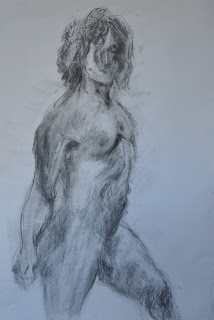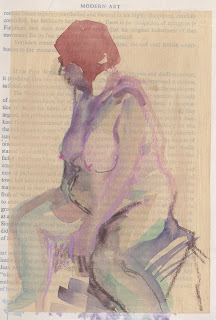 |
| watercolour on book page, A Bold Venture |
It's tempting to do the same thing and perhaps repeat the same errors. I guess one of the questions the NEAC drawing scholarship has made me think about is what assumptions do I bring to my drawing that are interfering with my observation? I am learning (anew) to look critically at what I am doing in order to do it better the next time. Sometimes, maybe even often, I return from one of my life drawing classes, a workshop or a studio visit feeling quite inadequate. In a way I also feel like a performing seal who hasn't learned the routine. But, of course what I don't want to do is to perform. What I do want to do is learn and progress.
One of my big 'fails' has been the three watercolour workshops I have taken part in. The teaching was good but I didn't have the time and head space, at the time to test things in a way that was relevant to me. I was trying to think like the teacher, because that seems to me to be the best way of getting the most out of a workshop. As a beginner with watercolour, I knew after the workshops that I would need to do a lot more of it later - until now I haven't had that elusive time. I have been thinking about things though, and in preparation for my exploration, I bought something that I learned about from Rebecca (life drawing) called 'watercolour ground' to paint on surfaces so the watercolour adheres in a similar way to watercolour paper. While at Great Art in London one day, I found some Daniel Smith Watercolor Ground. There were other varieties, but the one I bought was on sale and in a smallish tub, so afordable. There wasn't any white, though, so I bought buff titanium. I painted that on a gessoed book page in my ongoing altered sketchbook, A Bold Venture.
Before beginning a watercolour, I began another project I have been wanting to start. My friend and mentor, Jack Heliker told me (when I had graduated from Stanford) that I should read Kimon Nicolaïdes' book The Natural Way to Draw, and complete all the exercises. Heliker and Nicolaïdes had both taught at the Art Students' League. In New York, I worked my way through some of the book. Recently, I decided that alongside my current Drawing School learning, going back to Nicolaïdes would be a good discipline.
The rules for the first session (3hrs total, of which I did 1 hour) were that you needed to not look at your paper, to draw the contour with a very sharp 3B pencil and to work on a piece of manila paper 15 x 20 inches. I couldn't find a 3B, so used a 4B and used a pink pig sketchbook, standing at an easel.
 |
| 30 minute contour drawing |
Beause I don't hold my pencil properly, my hand got very tired. My brain got very tired and in the first drawing I looked at my paper to find a place to start quite a few times. In the second drawing, below, my drawing became smaller and smaller, but I really tried to feel the contours.
 |
| 30 minute contour drawing |
After really looking for that hour, I moved over to the watercolour experiment. I explored the techniques Neil had shown us. My book was on an easel, so it dripped, but I used paper towels and Q-tips to mop up. Lots ot think about… quite a challenge!






















